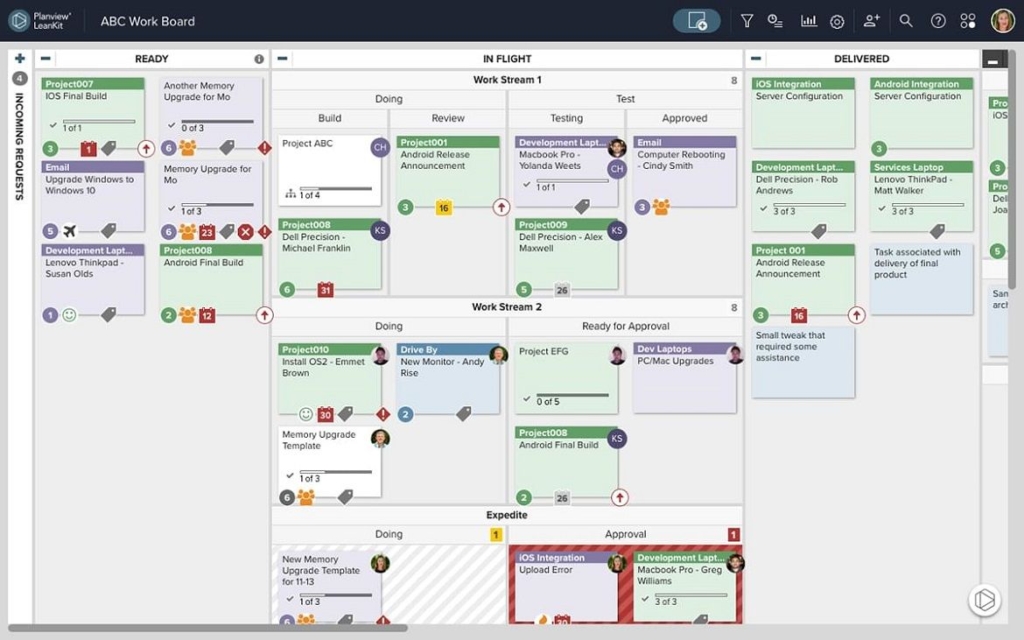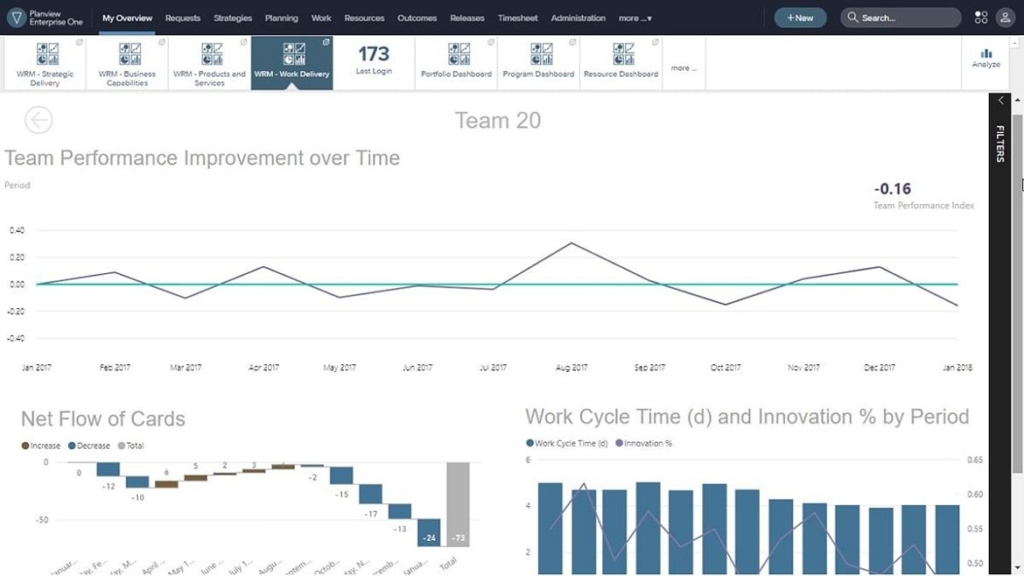Kanban – the Japanese word for “visual signal” or “card” – is a workflow management method used to visualize work, limit work-in-process, and foster continuous improvement. Kanban is used by individuals and teams in all industries to improve communication, enable more effective collaboration, and get more done, faster.
Get familiar with some key Kanban terms in our Kanban glossary.
Kanban Roadmap: How to Get Started in 5 Easy Steps
You and your team can build a Kanban board in just 5 easy steps. Learn how.
View the eBook • Kanban RoadmapAgilePlace Free Trial: AgilePlace Online Kanban Software
Sign up for a 30-day free trial and you and your team can start building online Kanban boards today. Experience for yourself how AgilePlace supports continuous delivery initiatives, eliminates waste and improves your team’s delivery processes and speed.
Start your Free Trial • AgilePlace Free Trial
Blocker
The goal for any piece of work represented on a Kanban board is to move it seamlessly from one process step to another, until the work is done. While visualizing work on a Kanban board does help enable better flow, sometimes unforeseen internal or external factors get in the way of progress. These factors are called blockers, because they block a card from being able to move forward in your process.
Board
The term Kanban board refers to one entire workflow – a set of lanes that together, represent a process. Teams might choose to use one shared Kanban board to manage their work, or they might use multiple connected boards to optimize each board for a specific workflow (for example, a marketing team might have one board to manage content creation, while another manages paid advertising campaigns).
Bottleneck
Like a blocker, a bottleneck is a constraint in the system that limits the flow of work. Unlike a blocker, which halts the flow of progress until it is removed, a bottleneck usually can be fixed through a concentrated effort or a redistribution of work. If, for example, a team of six developers has only one QA person, it’s likely that there will be a buildup of work in the QA lane. Dedicating another person to performing QA could help alleviate this bottleneck.

Identifying bottlenecks makes it easier to reduce their impact and provides a mechanism for controlling the way work flows through your process.
Contexting
Also known as Task Switching or Multitasking, Context switching is what happens when we stretch our focus, time, attention, and brain power across too many objects in motion. When we juggle too many projects at once, we waste these precious resources transitioning between contexts, instead of adding value to work.
Context switching is incredibly draining, making us less productive while increasing our stress. The dreaded question, “Do you have five minutes?” can easily put a task 45 minutes behind schedule.
Hidden WIP
WIP is an acronym for Work in Process (See Work in Process). For teams practicing Kanban, visualizing all WIP on the board is critical for accurately managing workflow. Hidden WIP is work that someone is actively working on but hasn’t been added to the board.
The danger of hidden WIP is that it hinders a team’s ability to understand capacity and can block the flow of progress.
Say, for example, a team has a policy that says no one on the team should be assigned to more than 3 cards. Bob is assigned to 3 cards and is also working on 2 hidden pieces of work. Bob is working hard, but his team doesn’t see any progress being made on the cards to which he is assigned. All three of the cards on the board require his attention before they can move forward in the process – so the other team members assigned to them must sit idle until Bob is able to look at them. Unintentionally, Bob’s hidden WIP has drastically delayed the team’s overall productivity.
Kanban System
This term describes your entire workflow – whether that’s one Kanban board that you use to manage your team’s work, or the 15 connected boards your organization uses to manage initiatives at every level. All work visualized and connected on a Kanban board or set of boards can be referred to as a Kanban system.
Process
The series of actions, steps or stages that a piece of work goes through to be considered “done.” A process can be as simple as “To Do, Doing, Done” or far more complicated. Both simple and complex process maps can be equally effective on a Kanban board as long as they accurately represent the flow of your work.
Process Map
A process map is a visual representation of the steps needed to complete a piece of work. If you manage your work on a Kanban board, you probably started by creating a process map. Process maps can help you understand how work moves between phases before it is completed.
Pull System
A work process where each stage only pulls work into progress when it has capacity to do so; the opposite of a push system, where work is assigned and added to a queue, regardless of capacity to complete it.
Using a pull system helps everyone feel accountable for and in control of their work.
It generally helps teams reduce WIP (See “Work in Process”), which can boost productivity across the team.
Visual Management
A philosophy that work is better managed through visual systems, such as Kanban, than text-based lists or spreadsheets. The philosophy posits that visualizing work as it’s being done better reveals problems at earlier stages, leading to lower cost solutions.
WIP (Work in Process)
WIP describes any piece of work that has been started but is not yet “done.” Kanban encourages individuals, teams, and organizations to limit their WIP, so that they can focus on delivering each piece of work as quickly as possible. The more WIP we have in our Kanban systems, the slower our systems operate.
WIP Limit
WIP limits are constraints on how many work items (cards) are actively being worked on at any given time. They can be implemented at the individual, team, and even organizational levels, although they’re most commonly used to manage capacity on team Kanban boards.
WIP limits can be implemented for the entire “in process” part of your Kanban board, for specific lanes, or both. There is no one correct way to implement WIP limits – although a general rule is that they should be slightly constraining. They should force us to make decisions regarding the priority, time sensitivity, and cost of delay of various projects. If your team never hits its WIP limit, this is probably a sign that your WIP limit is too high.
Summary
Kanban boards allow real-time awareness of the health and state of all work within and across teams. They provide the necessary level of detail to track progress and identify potential problems, from a single team and board to hundreds of teams across the enterprise.
